Integrating Blockchain in Smart Grids for Enhanced Demand Response: Challenges, Strategies, and Future Directions
Abstract
1. Introduction
- How/Can blockchain technology be effectively integrated into SGs to enhance the efficiency and security of DR systems?
- What are the key challenges and opportunities associated with the adoption of blockchain in DR within SGs?
1.1. The Emergence of Demand Response
1.2. The Rising Potential of Blockchain
1.3. Main Goals of the Research
- To undertake a detailed examination of DR, focusing on its current challenges, opportunities, and role in modern energy systems. This will provide a foundational understanding of how blockchain technology can be applied to optimize and revolutionize DR.
- To analyze the existing applications of blockchain in SGs, identifying gaps in knowledge and implementation. This will help in pinpointing areas where blockchain can be most effectively utilized in DR.
- To analyze the principles of blockchain technology, including its architecture, distributed consensus mechanisms, and the use of SCs. Comprehending these key elements is crucial for assessing blockchain’s applicability in DR and SGs.
- To evaluate various blockchain models such as public, private, and consortium blockchains, investigating their respective strengths and weaknesses. This assessment will guide the selection of the appropriate blockchain type for different DR scenarios.
- To present practical use cases of blockchain in the energy sector, particularly concerning DR. This includes exploring the challenges that must be navigated for successful blockchain implementation, such as technological, regulatory, and infrastructural issues.
- To assess how blockchain can be seamlessly integrated with existing DR systems to enhance their efficiency, transparency, and security. The study will also examine the potential of SCs in automating DR processes and blockchain’s role in creating fair and transparent energy markets.
2. Materials and Methods
2.1. Data Collection and Sources
2.2. Methodological Approach
2.3. Phased Structure of Research
- Establishing Theoretical Groundwork: the initial phase involved analyzing secondary data to build a theoretical foundation and identify gaps in the existing body of knowledge.
- Primary Data Examination: this stage comprised a detailed exploration of case studies, focusing on blockchain applications in DR within SGs.
- Qualitative Analysis and Synthesis: following the primary data collection, a comprehensive qualitative analysis was conducted. This phase aimed to draw practical insights and assess the role and impact of blockchain technology in DR.
- Formulating Conclusions: the final phase involved synthesizing the theoretical and practical findings to arrive at comprehensive conclusions and strategic recommendations for future research and applications in the field.
3. Demand Response Analysis
The Adoption of Blockchain in Demand Response
4. Blockchain Technology Analysis
4.1. Fundamental Principles, Distributed Consensus and Smart Contracts
4.1.1. Distributed Consensus Algorithms
4.1.2. Key Characteristics of Blockchain
4.2. Blockchain Network Types
4.2.1. Advantages of Public Blockchains
4.2.2. Advantages of Private Blockchains
4.2.3. Main Blockchain Platforms
5. Blockchain-Based Solutions to Accelerate DR Adoption
5.1. Public Blockchain Networks
5.2. Private Blockchain Networks
6. Discussion
6.1. Impact of Blockchain and AI-Driven DR Optimization and Forecasting
6.2. Blockchain’s Role in Energy Sustainability and Consumer Empowerment
6.3. Comparing Different Blockchain Applications in DR Scenarios
7. Challenges and Implications of Blockchain in DR
7.1. Technological and Infrastructure Challenges
7.2. Economic Considerations and Market Dynamics
7.3. Regulatory Frameworks and Ethical Implications
7.4. Consumer Engagement and Security
7.5. Sustainability Concerns
8. Conclusions
- Research Question 1: How/Can blockchain technology be effectively integrated into SGs to enhance the efficiency and security of DR systems? Our research indicates a positive affirmation, with empirical evidence suggesting significant improvements in both efficiency and security.
- Research Question 2: What are the key challenges and opportunities associated with the adoption of blockchain in DR within SGs? We identified critical challenges, such as scalability and interoperability, alongside opportunities for enhancing consumer engagement and system transparency.
8.1. Future Directions
8.1.1. Detailed Technological Improvements and Innovations
8.1.2. Economic and Market Analysis
8.1.3. Regulatory and Policy Frameworks
8.1.4. Societal Implications and Consumer Engagement
8.1.5. Environmental Sustainability and Renewable Energy Integration
8.1.6. Security, Privacy, and Trust in Blockchain Systems
Author Contributions
Funding
Institutional Review Board Statement
Informed Consent Statement
Data Availability Statement
Conflicts of Interest
Abbreviations
| AI | Artificial Intelligence |
| BFT | Byzantine Fault Tolerance |
| BRP | Balance Responsible Party |
| DApps | Decentralized Applications |
| DCS | Distributed Control System |
| DER | Distributed Energy Resources |
| DLT | Distributed Ledger Technology |
| DR | Demand Response |
| DSM | Demand-Side Management |
| DSOs | Distribution System Operators |
| EMS | Energy Management System |
| EV | Electric Vehicle |
| IoT | Internet of Things |
| ISO | Independent System Operator |
| MG | Micro-Grid |
| MILP | Mixed Integer Linear Programming |
| OPF | Optimal Power Flow |
| P2P | Peer-to-Peer |
| PBFT | Practical Byzantine Fault Tolerance |
| PoS | Proof of Stake |
| PoW | Proof of Work |
| RES | Renewable Energy Sources |
| RTP | Real-Time Pricing |
| SC | Smart Contracts |
| SCADA | Supervisory Control and Data Acquisition |
| SG | Smart Grid |
| SO | System Operator |
| TOU | Time-of-Use |
| TSOs | Transmission System Operators |
References
- Newell, R.G.; Raimi, D. Global Energy Outlook Comparison Methods: 2020 Update; Technical Report; Resources for the Future: Washington, DC, USA, 2020; Available online: https://www.rff.org/publications/reports/global-energy-outlook-comparison-methods-2020 (accessed on 14 January 2024).
- Sugiawan, Y.; Managi, S. New evidence of energy-growth nexus from inclusive wealth. Renew. Sustain. Energy Rev. 2019, 103, 40–48. [Google Scholar] [CrossRef]
- Khraief, N.; Shahbaz, M.; Mallick, H.; Loganathan, N. Estimation of electricity demand function for Algeria: Revisit of time series analysis. Renew. Sustain. Energy Rev. 2018, 82, 4221–4234. [Google Scholar] [CrossRef]
- United Nations Climate Change. The Paris Agreement. 2015. Available online: https://unfccc.int/process-and-meetings/the-paris-agreement (accessed on 14 January 2024).
- Lorestani, A.; Ardehali, M. Optimization of autonomous combined heat and power system including PVT, WT, storages, and electric heat utilizing novel evolutionary particle swarm optimization algorithm. Renew. Energy 2018, 119, 490–503. [Google Scholar] [CrossRef]
- Garlet, T.B.; Ribeiro, J.L.D.; de Souza Savian, F.; Mairesse Siluk, J.C. Paths and barriers to the diffusion of distributed generation of photovoltaic energy in southern Brazil. Renew. Sustain. Energy Rev. 2019, 111, 157–169. [Google Scholar] [CrossRef]
- Singh, B.; Sharma, J. A review on distributed generation planning. Renew. Sustain. Energy Rev. 2017, 76, 529–544. [Google Scholar] [CrossRef]
- Amin, S.; Wollenberg, B. Toward a Smart Grid: Power delivery for the 21st century. IEEE Power Energy Mag. 2005, 3, 34–41. [Google Scholar] [CrossRef]
- Zheng, Y.; Xu, Y.; Qiu, Z. Blockchain Traceability Adoption in Agricultural Supply Chain Coordination: An Evolutionary Game Analysis. Agriculture 2023, 13, 184. [Google Scholar] [CrossRef]
- Albadi, M.H.; El-Saadany, E.F. Demand Response in Electricity Markets: An Overview. In Proceedings of the 2007 IEEE Power Engineering Society General Meeting, Tampa, FL, USA, 24–28 June 2007; pp. 1–5. [Google Scholar] [CrossRef]
- Farhangi, H. The Path of the Smart Grid. IEEE Power Energy Mag. 2010, 8, 18–28. [Google Scholar] [CrossRef]
- Lund, H.; Andersen, A.; Østergaard, P.; Mathiesen, B.; Connolly, D. From electricity smart grids to smart energy systems—A market operation based approach and understanding. Energy 2012, 42, 96–102. [Google Scholar] [CrossRef]
- Parag, Y.; Sovacool, B. Electricity market design for the prosumer era. Nat. Energy 2016, 1, 16032. [Google Scholar] [CrossRef]
- Gungor, V.; Sahin, D.; Kocak, T.; Ergut, S.; Buccella, C.; Cecati, C.; Hancke, G. A Survey on Smart Grid Potential Applications and Communication Requirements. IEEE Trans. Ind. Inform. 2013, 9, 28–42. [Google Scholar] [CrossRef]
- Tsalikidis, N.; Mystakidis, A.; Tjortjis, C.; Koukaras, P.; Ioannidis, D. Energy load forecasting: One-step ahead hybrid model utilizing ensembling. Computing 2023, 106, 241–273. [Google Scholar] [CrossRef]
- Mystakidis, A.; Tsalikidis, N.; Koukaras, P.; Kontoulis, C.; Gkaidatzis, P.A.; Ioannidis, D.; Tjortjis, C.; Tzovaras, D. Power Load Forecasting: A Time-Series Multi-Step Ahead and Multi-Model Analysis. In Proceedings of the 2023 58th International Universities Power Engineering Conference (UPEC), Dublin, Ireland, 30 August–1 September 2023; IEEE: Piscataway, NJ, USA, 2023; pp. 1–6. [Google Scholar] [CrossRef]
- Mystakidis, A.; Ntozi, E.; Afentoulis, K.; Koukaras, P.; Gkaidatzis, P.; Ioannidis, D.; Tjortjis, C.; Tzovaras, D. Energy generation forecasting: Elevating performance with machine and deep learning. Computing 2023, 105, 1623–1645. [Google Scholar] [CrossRef]
- Koukaras, P.; Berberidis, C.; Tjortjis, C. A Semi-supervised Learning Approach for Complex Information Networks. In Proceedings of the Intelligent Data Communication Technologies and Internet of Things; Hemanth, J., Bestak, R., Chen, J.I.Z., Eds.; Springer: Singapore, 2021; pp. 1–13. [Google Scholar] [CrossRef]
- Lu, Y.; Khan, Z.A.; Alvarez-Alvarado, M.S.; Zhang, Y.; Huang, Z.; Imran, M. A Critical Review of Sustainable Energy Policies for the Promotion of Renewable Energy Sources. Sustainability 2020, 12, 5078. [Google Scholar] [CrossRef]
- Palensky, P.; Dietrich, D. Demand Side Management: Demand Response, Intelligent Energy Systems, and Smart Loads. IEEE Trans. Ind. Inform. 2011, 7, 381–388. [Google Scholar] [CrossRef]
- Siano, P. Demand response and smart grids—A survey. Renew. Sustain. Energy Rev. 2014, 30, 461–478. [Google Scholar] [CrossRef]
- Aitzhan, N.Z.; Svetinovic, D. Security and Privacy in Decentralized Energy Trading Through Multi-Signatures, Blockchain and Anonymous Messaging Streams. IEEE Trans. Dependable Secur. Comput. 2018, 15, 840–852. [Google Scholar] [CrossRef]
- Wang, Z.; Zhang, Z.; Xuefei, Z.; Jing, X.; Fujian, C. Research on distribution network data fusion considering renewable energy. In Proceedings of the 2017 2nd International Conference on Power and Renewable Energy (ICPRE), Chengdu, China, 20–23 September 2017; pp. 500–504. [Google Scholar] [CrossRef]
- Baliga, A. Understanding blockchain consensus models. Persistent 2017, 4, 14. [Google Scholar]
- Afzal, M.; Li, J.; Amin, W.; Huang, Q.; Umer, K.; Ahmad, S.; Ahmad, F.; Solangi, A. Role of blockchain technology in transactive energy market: A review. Sustain. Energy Technol. Assess. 2022, 53, 102646. [Google Scholar] [CrossRef]
- Roth, T.; Utz, M.; Baumgarte, F.; Rieger, A.; Sedlmeir, J. Electricity powered by blockchain: A review with a European perspective. Appl. Energy 2022, 325, 119799. [Google Scholar] [CrossRef]
- Andoni, M.; Robu, V.; Flynn, D.; Abram, S.; Geach, D.; Jenkins, D.; McCallum, P.; Peacock, A. Blockchain technology in the energy sector: A systematic review of challenges and opportunities. Renew. Sustain. Energy Rev. 2019, 100, 143–174. [Google Scholar] [CrossRef]
- Federal Energy Regulatory Commission. Assessment of Demand Response and Advanced Metering. Technical Report, Federal Energy Regulatory Commission (FERC). 2022. Available online: https://www.ferc.gov/media/2022-assessment-demand-response-and-advanced-metering (accessed on 12 January 2024).
- Paterakis, N.; Erdinç, O.; Catalão, J. An overview of Demand Response: Key-elements and international experience. Renew. Sustain. Energy Rev. 2017, 69, 871–891. [Google Scholar] [CrossRef]
- Chai, Y.; Xiang, Y.; Liu, J.; Gu, C.; Zhang, W.; Xu, W. Incentive-based demand response model for maximizing benefits of electricity retailers. J. Mod. Power Syst. Clean Energy 2019, 7, 1644–1650. [Google Scholar] [CrossRef]
- Ante, L.; Steinmetz, F.; Fiedler, I. Blockchain and energy: A bibliometric analysis and review. Renew. Sustain. Energy Rev. 2021, 137, 110597. [Google Scholar] [CrossRef]
- Choobineh, M.; Arab, A.; Khodaei, A.; Paaso, A. Energy innovations through blockchain: Challenges, opportunities, and the road ahead. Electr. J. 2022, 35, 107059. [Google Scholar] [CrossRef]
- Mengelkamp, E.; Gärttner, J.; Rock, K.; Kessler, S.; Orsini, L.; Weinhardt, C. Designing microgrid energy markets. Appl. Energy 2018, 210, 870–880. [Google Scholar] [CrossRef]
- Li, Z.; Kang, J.; Yu, R.; Ye, D.; Deng, Q.; Zhang, Y. Consortium Blockchain for Secure Energy Trading in Industrial Internet of Things. IEEE Trans. Ind. Inform. 2018, 14, 3690–3700. [Google Scholar] [CrossRef]
- Narayanan, A.; Bonneau, J.; Felten, E.; Miller, A.; Goldfeder, S. Bitcoin and Cryptocurrency Technologies: A Comprehensive Introduction; Princeton University Press: Princeton, NJ, USA, 2016; Available online: https://www.uio.no/studier/emner/matnat/ifi/IN5420/v18/timeplan/resources/bitcoin-and-cryptocurrency-techniques.pdf (accessed on 14 January 2024).
- Zheng, Z.; Xie, S.; Dai, H.; Chen, X.; Wang, H. An Overview of Blockchain Technology: Architecture, Consensus, and Future Trends. In Proceedings of the 2017 IEEE International Congress on Big Data (BigData Congress), Honolulu, HI, USA, 25–30 June 2017; IEEE: Piscataway, NJ, USA, 2017. [Google Scholar] [CrossRef]
- Swan, M. Blockchain: Blueprint for a New Economy; O’Reilly Media, Inc.: Sebastopol, CA, USA, 2015; Available online: https://www.academia.edu/44112222 (accessed on 14 January 2024).
- Afzal, M.; Huang, Q.; Amin, W.; Umer, K.; Solangi, A.; Naeem, M. Blockchain Enabled Distributed Demand Side Management in Community Energy System With Smart Homes. IEEE Access 2020, 8, 37428–37439. [Google Scholar] [CrossRef]
- Antonopoulos, A.M. Mastering Bitcoin: Unlocking Digital Cryptocurrencies; O’Reilly Media, Inc.: Sebastopol, CA, USA, 2014; Available online: https://www.oreilly.com/library/view/mastering-bitcoin/9781491902639 (accessed on 13 January 2024).
- Walport, M. Distributed LEDGER Technology: Beyond Blockchain; Government Office for Science: London, UK, 2016; Volume 1, pp. 1–88. Available online: https://assets.publishing.service.gov.uk/media/5a818d6fe5274a2e87dbe3dd/gs-16-1-distributed-ledger-technology.pdf (accessed on 13 January 2024).
- King, S.; Nadal, S. Ppcoin: Peer-to-Peer Crypto-Currency with Proof-of-Stake. 19 August 2012. Available online: https://api.semanticscholar.org/CorpusID:42319203 (accessed on 15 January 2024).
- Castro, M. Practical Byzantine fault tolerance. In Proceedings of the USENIX Symposium on Operating Systems Design and Implementation, New Orleans, LO, USA, 22–25 February 1999; Available online: https://www.usenix.org/conference/osdi-99/practical-byzantine-fault-tolerance (accessed on 13 January 2024).
- Dorri, A.; Hill, A.; Kanhere, S.; Jurdak, R.; Luo, F.; Dong, Z.Y. Peer-to-Peer EnergyTrade: A Distributed Private Energy Trading Platform. In Proceedings of the 2019 IEEE International Conference on Blockchain and Cryptocurrency (ICBC), Seoul, Republic of Korea, 14–17 May 2019; IEEE: Piscataway, NJ, USA, 2019. [Google Scholar] [CrossRef]
- Wen, S.; Xiong, W.; Tan, J.; Chen, S.; Li, Q. Blockchain Enhanced Price Incentive Demand Response for Building User Energy Network in Sustainable Society. Sustain. Cities Soc. 2021, 68, 102748. [Google Scholar] [CrossRef]
- Hawlitschek, F.; Notheisen, B.; Teubner, T. The limits of trust-free systems: A literature review on blockchain technology and trust in the sharing economy. Electron. Commer. Res. Appl. 2018, 29, 50–63. [Google Scholar] [CrossRef]
- Heires, K. The risks and rewards of blockchain technology. Risk Management. 1 March 2016. Available online: https://www.rmmagazine.com/articles/article/2016/03/01/-The-Risks-and-Rewards-of-Blockchain-Technology- (accessed on 13 January 2024).
- Tapscott, D.; Tapscott, A. Blockchain Revolution: How the Technology Behind Bitcoin Is Changing Money, Business, and the World; Penguin: London, UK, 2016; Available online: https://www.amazon.com/Blockchain-Revolution-Technology-Cryptocurrencies-Changing/dp/1101980141 (accessed on 13 January 2024).
- Mik, E. Smart contracts: Terminology, technical limitations and real world complexity. Law Innov. Technol. 2017, 9, 269–300. [Google Scholar] [CrossRef]
- European Parliament; European Parliamentary Research Services; Boucher, P.; Nascimento, S.; Kritikos, M. How Blockchain Technology Could Change Our Lives—In-Depth Analysis; European Union: Brussels, Belgium, 2017. [Google Scholar] [CrossRef]
- Neyer, G.; Geva, B. Blockchain and payment systems: What are the benefits and costs? J. Payments Strategy Syst. 2017, 11, 215–225. Available online: https://api.semanticscholar.org/CorpusID:217055353 (accessed on 13 January 2024).
- Hamida, E.B.; Brousmiche, K.L.; Levard, H.; Thea, E. Blockchain for Enterprise: Overview, Opportunities and Challenges. In Proceedings of the International Conference on Wireless and Mobile Communications, Nice, France, 23–27 July 2017; Available online: https://hal.science/hal-01591859 (accessed on 11 January 2024).
- Zheng, Z.; Xie, S.; Dai, H.; Chen, X.; Wang, H. Blockchain challenges and opportunities: A survey. Int. J. Web Grid Serv. 2018, 14, 352–375. [Google Scholar] [CrossRef]
- Nakamoto, S. Bitcoin: A Peer-to-Peer Electronic Cash System. Decentralized Business Review. 2008. Available online: https://bitcoin.org/bitcoin.pdf (accessed on 14 January 2024).
- Buterin, V. A next-generation smart contract and decentralized application platform. White Pap. 2014, 3, 1–36. Available online: https://api.semanticscholar.org/CorpusID:19568665 (accessed on 14 January 2024).
- Swanson, T. Consensus-as-a-Service: A Brief Report on the Emergence of Permissioned, Distributed Ledger Systems. Report 2015. Available online: http://www.ofnumbers.com/wp-content/uploads/2015/04/Permissioned-distributed-ledgers.pdf (accessed on 14 January 2024).
- The Linux Foundation. Hyperledger Fabric—Hyperledger Foundation. 2020. Available online: https://www.hyperledger.org/projects/fabric (accessed on 14 January 2024).
- Brown, R. The Corda Non-Technical Whitepaper. 2016. Available online: https://www.corda.net/content/corda-platform-whitepaper.pdf (accessed on 14 January 2024).
- Toyoda, K.; Mathiopoulos, P.T.; Sasase, I.; Ohtsuki, T. A Novel Blockchain-Based Product Ownership Management System (POMS) for Anti-Counterfeits in the Post Supply Chain. IEEE Access 2017, 5, 17465–17477. [Google Scholar] [CrossRef]
- Ma, C.; Kong, X.; Lan, Q.; Zhou, Z. The privacy protection mechanism of Hyperledger Fabric and its application in supply chain finance. Cybersecurity 2019, 2, 5. [Google Scholar] [CrossRef]
- Androulaki, E.; Barger, A.; Bortnikov, V.; Cachin, C.; Christidis, K.; De Caro, A.; Enyeart, D.; Ferris, C.; Laventman, G.; Manevich, Y.; et al. Hyperledger Fabric: A Distributed Operating System for Permissioned Blockchains. In Proceedings of the Thirteenth EuroSys Conference, EuroSys ’18, New York, NY, USA, 23–26 April 2018. [Google Scholar] [CrossRef]
- Zhang, C.; Wu, J.; Zhou, Y.; Cheng, M.; Long, C. Peer-to-Peer energy trading in a Microgrid. Appl. Energy 2018, 220, 1–12. [Google Scholar] [CrossRef]
- Manevich, Y.; Barger, A.; Tock, Y. Service Discovery for Hyperledger Fabric. In Proceedings of the 12th ACM International Conference on Distributed and Event-Based Systems, DEBS ’18, New York, NY, USA, 25–29 June 2018; pp. 226–229. [Google Scholar] [CrossRef]
- Clack, C.D.; Bakshi, V.A.; Braine, L. Smart contract templates: Foundations, design landscape and research directions. arXiv 2016, arXiv:1608.00771. [Google Scholar]
- Pop, C.; Cioara, T.; Antal, M.; Anghel, I.; Salomie, I.; Bertoncini, M. Blockchain based decentralized management of demand response programs in smart energy grids. Sensors 2018, 18, 162. [Google Scholar] [CrossRef]
- Pop, C.D.; Antal, M.; Cioara, T.; Anghel, I.; Salomie, I. Blockchain and Demand Response: Zero-Knowledge Proofs for Energy Transactions Privacy. Sensors 2020, 20, 5678. [Google Scholar] [CrossRef]
- Mao, X.; Xue, M.; Zhang, T.; Tan, W.; Zhang, Z.; Pan, Y.; Wu, H.; Lin, Z. Centralized bidding mechanism of demand response based on blockchain. Energy Rep. 2022, 8, 111–117. [Google Scholar] [CrossRef]
- Park, K.; Lee, J.; Das, A.K.; Park, Y. BPPS: Blockchain-Enabled Privacy-Preserving Scheme for Demand-Response Management in Smart Grid Environments. IEEE Trans. Dependable Secur. Comput. 2022, 22, 1719–1729. [Google Scholar] [CrossRef]
- Wu, X.; Duan, B.; Yan, Y.; Zhong, Y. M2M blockchain: The case of demand side management of smart grid. In Proceedings of the International Conference on Parallel and Distributed Systems—ICPADS, Shenzhen, China, 15–17 December 2017; IEEE: Piscataway, NJ, USA, 2018; pp. 810–813. [Google Scholar] [CrossRef]
- Van Cutsem, O.; Ho Dac, D.; Boudou, P.; Kayal, M. Cooperative energy management of a community of smart-buildings: A Blockchain approach. Int. J. Electr. Power Energy Syst. 2020, 117, 105643. [Google Scholar] [CrossRef]
- Tsao, Y.C.; Thanh, V.V.; Wu, Q. Sustainable microgrid design considering blockchain technology for real-time price-based demand response programs. Int. J. Electr. Power Energy Syst. 2021, 125, 106418. [Google Scholar] [CrossRef]
- Tsolakis, A.C.; Moschos, I.; Votis, K.; Ioannidis, D.; Dimitrios, T.; Pandey, P.; Katsikas, S.; Kotsakis, E.; Garcia-Castro, R. A Secured and Trusted Demand Response system based on Blockchain technologies. In Proceedings of the 2018 IEEE (SMC) International Conference on Innovations in Intelligent Systems and Applications, INISTA 2018, Thessaloniki, Greece, 3–5 July 2018; IEEE: Piscataway, NJ, USA, 2018; pp. 1–6. [Google Scholar] [CrossRef]
- Openadralliance. 2022. Available online: https://www.openadr.org/ (accessed on 5 January 2024).
- Zhou, Z.; Wang, B.; Guo, Y.; Zhang, Y. Blockchain and Computational Intelligence Inspired Incentive-Compatible Demand Response in Internet of Electric Vehicles. IEEE Trans. Emerg. Top. Comput. Intell. 2019, 3, 205–216. [Google Scholar] [CrossRef]
- Samadi, M.; Schriemer, H.; Ruj, S.; Erol-Kantarci, M. Energy Blockchain for Demand Response and Distributed Energy Resource Management. In Proceedings of the 2021 IEEE International Conference on Communications, Control, and Computing Technologies for Smart Grids (SmartGridComm), Aachen, Germany, 25–28 October 2021; pp. 425–431. [Google Scholar] [CrossRef]
- Guo, Z.; Ji, Z.; Wang, Q. Blockchain-enabled demand response scheme with individualized incentive pricing mode. Energies 2020, 13, 5213. [Google Scholar] [CrossRef]
- Bracciale, L.; Loreti, P.; Raso, E.; Bianchi, G.; Gallo, P.; Sanseverino, E.R. A Privacy-Preserving Blockchain Solution to Support Demand Response in Energy Trading. In Proceedings of the 2022 IEEE 21st Mediterranean Electrotechnical Conference (MELECON), Palermo, Italy, 14–16 June 2022; pp. 677–682. [Google Scholar] [CrossRef]
- Lucas, A.; Geneiatakis, D.; Soupionis, Y.; Nai-Fovino, I.; Kotsakis, E. Blockchain Technology Applied to Energy Demand Response Service Tracking and Data Sharing. Energies 2021, 14, 1881. [Google Scholar] [CrossRef]
- Danzi, P.; Hambridge, S.; Stefanovic, C.; Popovski, P. Blockchain-Based and Multi-Layered Electricity Imbalance Settlement Architecture. In Proceedings of the 2018 IEEE International Conference on Communications, Control, and Computing Technologies for Smart Grids, SmartGridComm 2018, Aalborg, Denmark, 29–31 October 2018. [Google Scholar] [CrossRef]
- Lin, Y.J.; Chen, Y.C.; Zheng, J.Y.; Chu, D.; Shao, D.W.; Yang, H.T. Blockchain Power Trading and Energy Management Platform. IEEE Access 2022, 10, 75932–75948. [Google Scholar] [CrossRef]
- Yang, Q.; Wang, H.; Wang, T.; Zhang, S.; Wu, X.; Wang, H. Blockchain-based decentralized energy management platform for residential distributed energy resources in a virtual power plant. Appl. Energy 2021, 294, 117026. [Google Scholar] [CrossRef]
- Deshpande, V.; George, L.; Badis, H.; Desta, A.A. Blockchain Based Decentralized Framework for Energy Demand Response Marketplace. In Proceedings of the IEEE/IFIP Network Operations and Management Symposium 2020: Management in the Age of Softwarization and Artificial Intelligence, NOMS 2020, Budapest, Hungary, 20–24 April 2020. [Google Scholar] [CrossRef]
- Di Silvestre, M.L.; Gallo, P.; Sanseverino, E.R.; Sciume, G.; Zizzo, G. A new architecture for Smart Contracts definition in Demand Response Programs. In Proceedings of the 2019 IEEE International Conference on Environment and Electrical Engineering and 2019 IEEE Industrial and Commercial Power Systems Europe, EEEIC/I and CPS Europe 2019, Genova, Italy, 11–14 June 2019; pp. 1–5. [Google Scholar] [CrossRef]
- Wang, L.; Jiao, S.; Xie, Y.; Mubaarak, S.; Zhang, D.; Liu, J.; Jiang, S.; Zhang, Y.; Li, M. A Permissioned Blockchain-Based Energy Management System for Renewable Energy Microgrids. Sustainability 2021, 13, 1317. [Google Scholar] [CrossRef]
- Merrad, Y.; Habaebi, M.H.; Toha, F.; Islam, M.R.; Gunawan, T.S.; Mesri, M. Fully Decentralized, Cost-Effective Energy Demand Response Management System with a Smart Contracts-Based Optimal Power Flow Solution for Smart Grids. Energies 2022, 15, 4461. [Google Scholar] [CrossRef]
- Li, Z.; Bahramirad, S.; Paaso, A.; Yan, M.; Shahidehpour, M. Blockchain for decentralized transactive energy management system in networked microgrids. Electr. J. 2019, 32, 58–72. [Google Scholar] [CrossRef]
- Augello, A.; Gallo, P.; Sanseverino, E.R.; Sciume, G.; Tornatore, M. A coexistence analysis of Blockchain, SCADA systems and OpenADR for Energy Services provision. IEEE Access 2022, 10, 99088–99101. [Google Scholar] [CrossRef]
- Sciume, G.; Palacios-Garcia, E.J.; Gallo, P.; Sanseverino, E.R.; Vasquez, J.C.; Guerrero, J.M. Demand Response Service Certification and Customer Baseline Evaluation Using Blockchain Technology. IEEE Access 2020, 8, 139313–139331. [Google Scholar] [CrossRef]
- DI Silvestre, M.L.; Gallo, P.; Sanseverino, E.R.; Sciume, G.; Zizzo, G. Aggregation and Remuneration in Demand Response with a Blockchain-Based Framework. IEEE Trans. Ind. Appl. 2020, 56, 4248–4257. [Google Scholar] [CrossRef]
- Makhdoom, I.; Abolhasan, M.; Abbas, H.; Ni, W. Blockchain’s adoption in IoT: The challenges, and a way forward. J. Netw. Comput. Appl. 2019, 125, 251–279. [Google Scholar] [CrossRef]
- Cachin, C.; Schubert, S.; Vukolić, M. Architecture of the Hyperledger Blockchain Fabric. In Proceedings of the Leibniz International Proceedings in Informatics; LIPIcs: Chicago, IL, USA, 2017; Volume 70, pp. 24.1–24.16. Available online: https://api.semanticscholar.org/CorpusID:15718952 (accessed on 13 January 2024).
- Xu, X.; Weber, I.; Staples, M.; Zhu, L.; Bosch, J.; Bass, L.; Pautasso, C.; Rimba, P. A Taxonomy of Blockchain-Based Systems for Architecture Design. In Proceedings of the 2017 IEEE International Conference on Software Architecture (ICSA), Gothenburg, Sweden, 3–7 April 2017; pp. 243–252. [Google Scholar] [CrossRef]
- Mihaylov, M.; Jurado, S.; Avellana, N.; Van Moffaert, K.; Magrans, I.; Nowe, A. NRGcoin: Virtual currency for trading of renewable energy in smart grids. In Proceedings of the International Conference on the European Energy Market, EEM, Kraków, Poland, 28–30 May 2014; pp. 1–6. [Google Scholar] [CrossRef]
- Teufel, B.; Sentic, A.; Barmet, M. Blockchain energy: Blockchain in future energy systems. J. Electron. Sci. Technol. 2019, 17, 100011. [Google Scholar] [CrossRef]
- Beck, R. Beyond Bitcoin: The Rise of Blockchain World. Computer 2018, 51, 54–58. [Google Scholar] [CrossRef]
- Sedlmeir, J.; Buhl, H.; Fridgen, G.; Keller, R. The Energy Consumption of Blockchain Technology: Beyond Myth. Bus. Inf. Syst. Eng. 2020, 62, 599–608. [Google Scholar] [CrossRef]
- Gunduz, M.Z.; Das, R. Analysis of cyber-attacks on smart grid applications. In Proceedings of the 2018 International Conference on Artificial Intelligence and Data Processing (IDAP), Malatya, Turkey, 28–30 September 2018; pp. 1–5. [Google Scholar] [CrossRef]
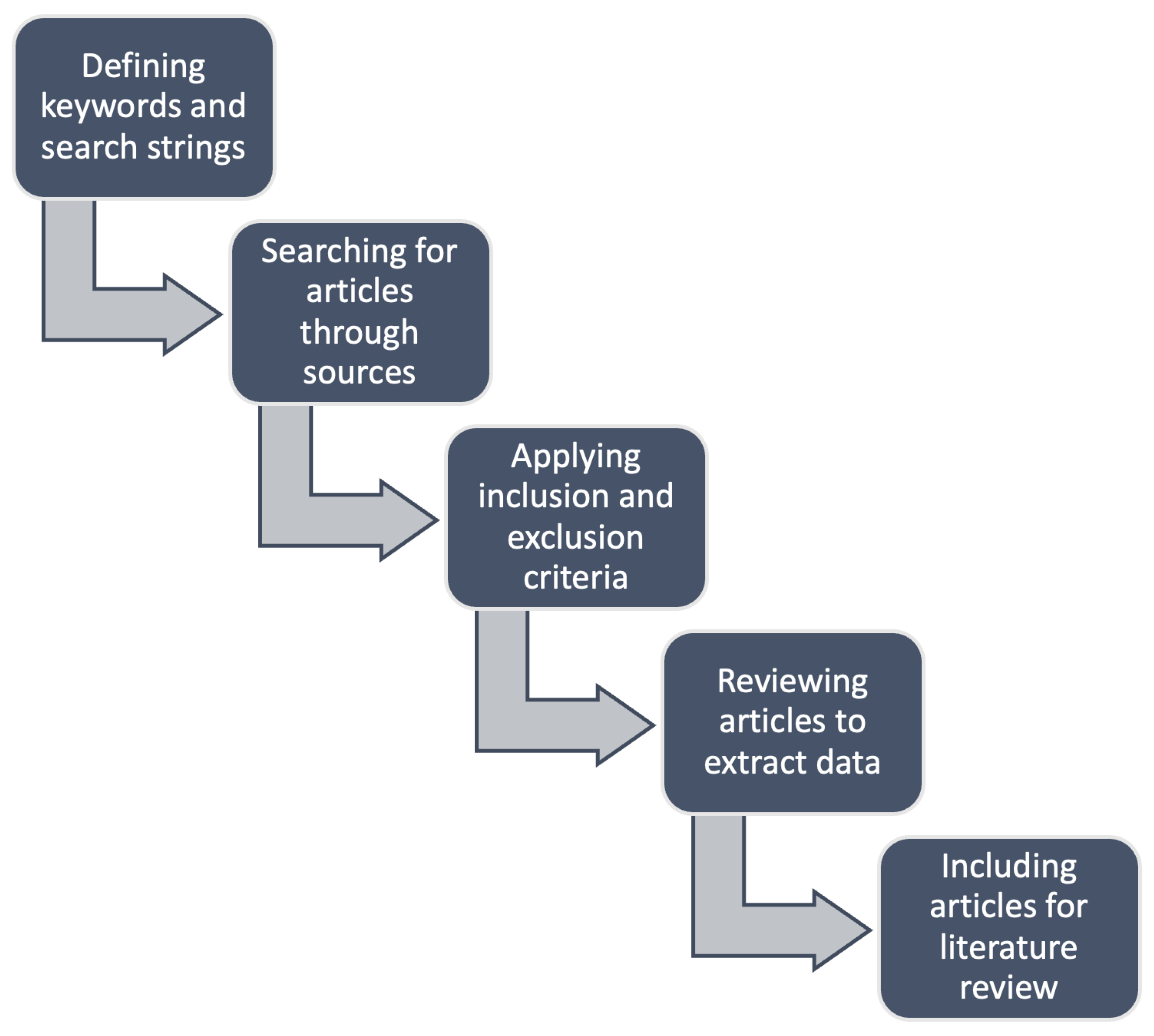
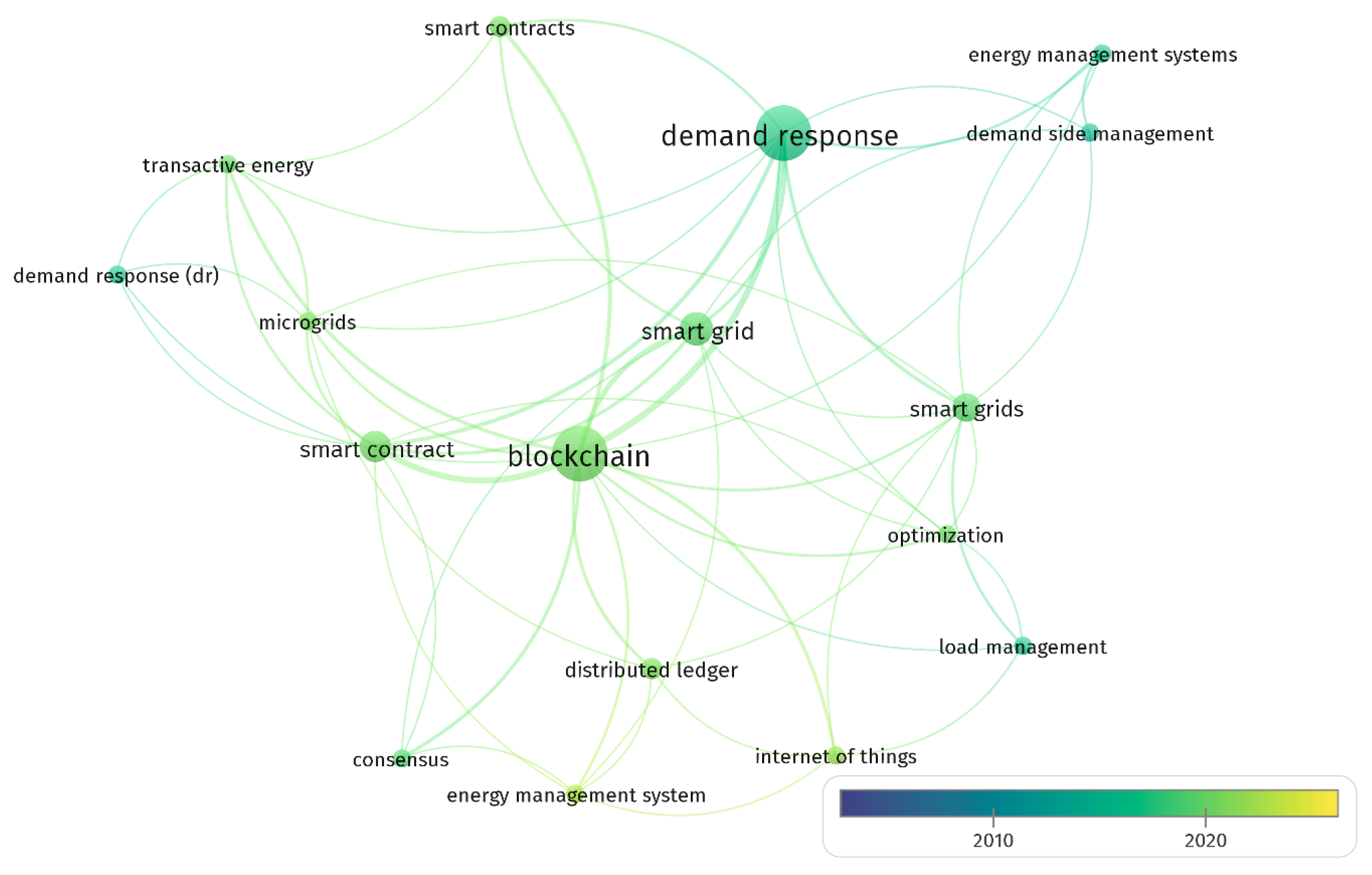
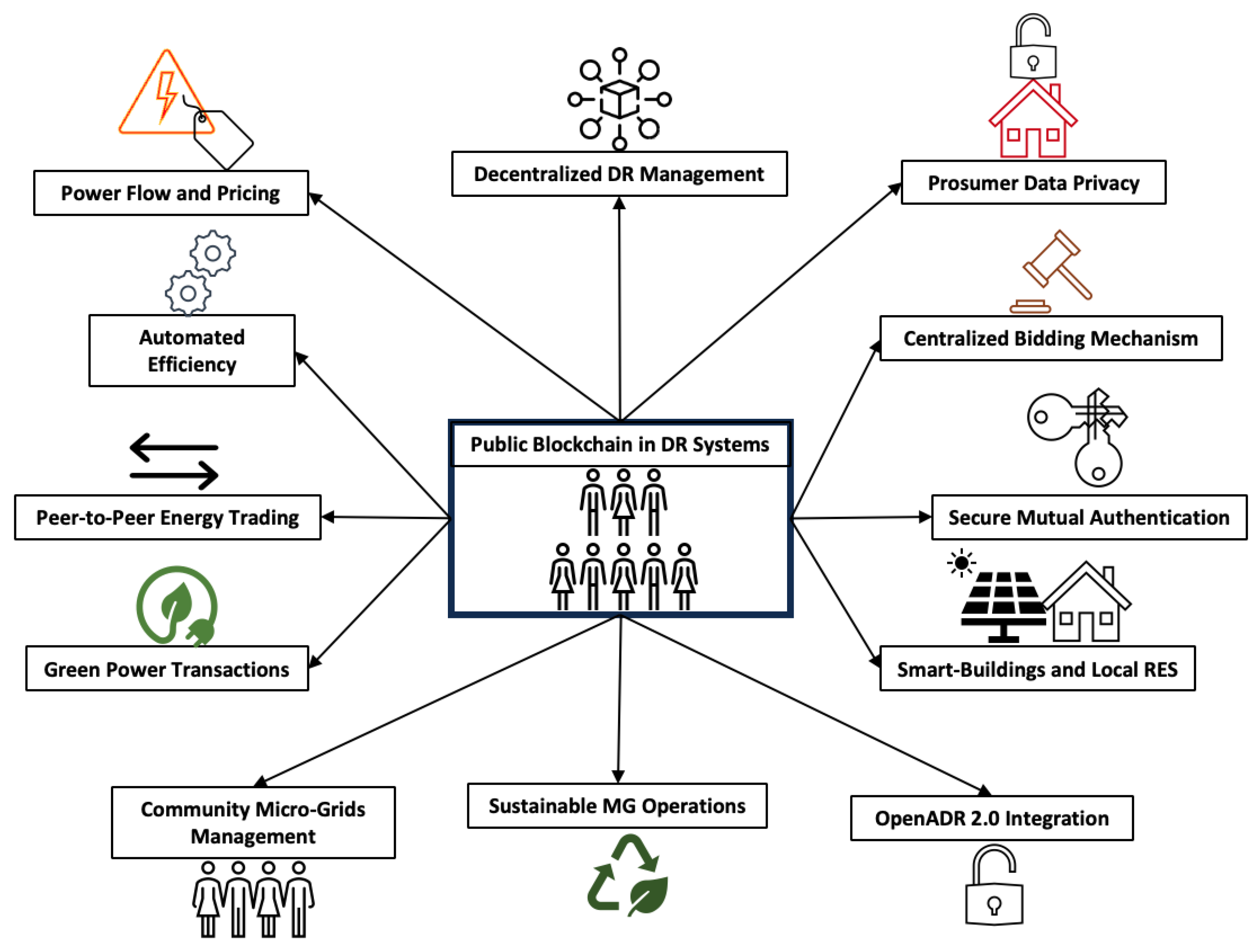
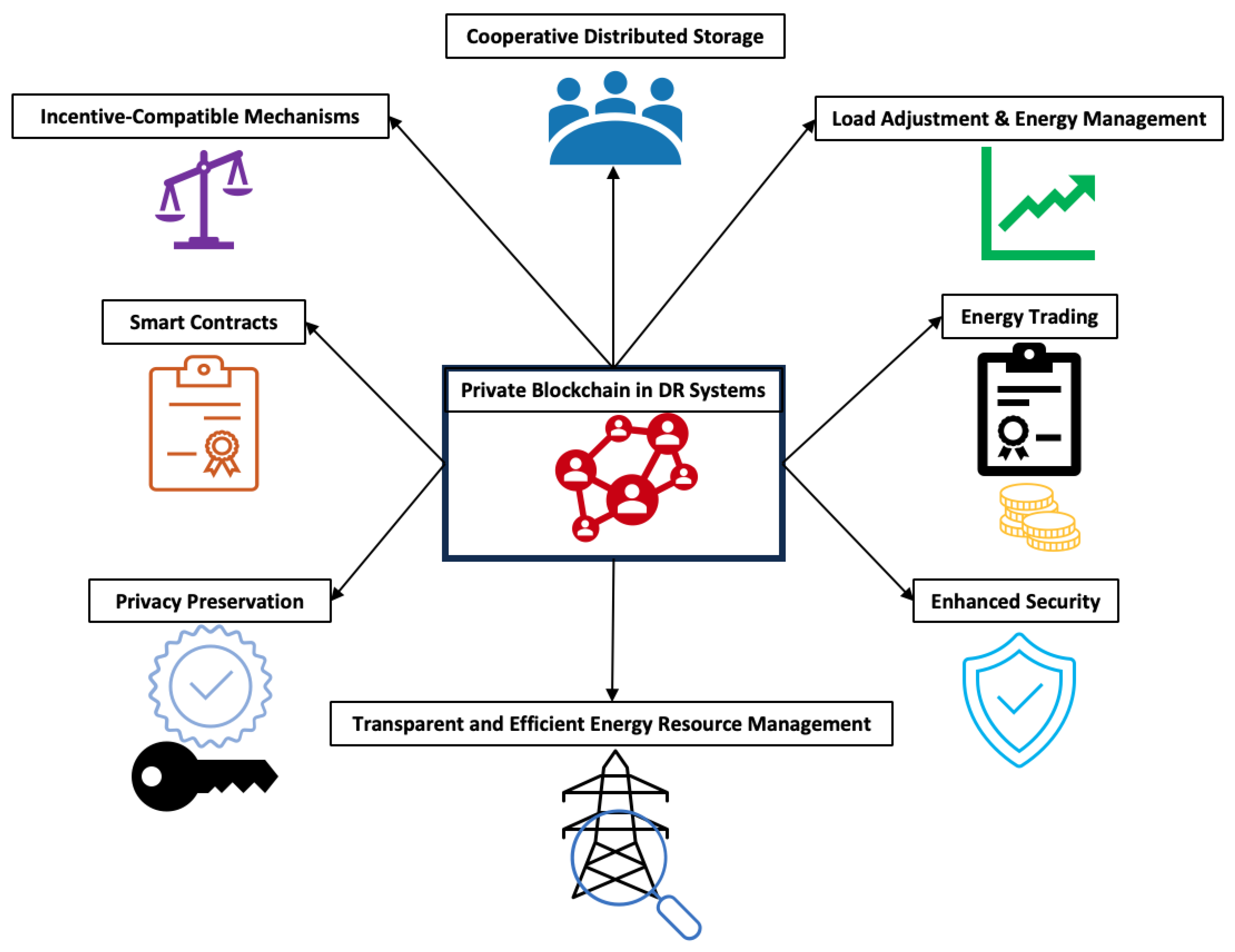

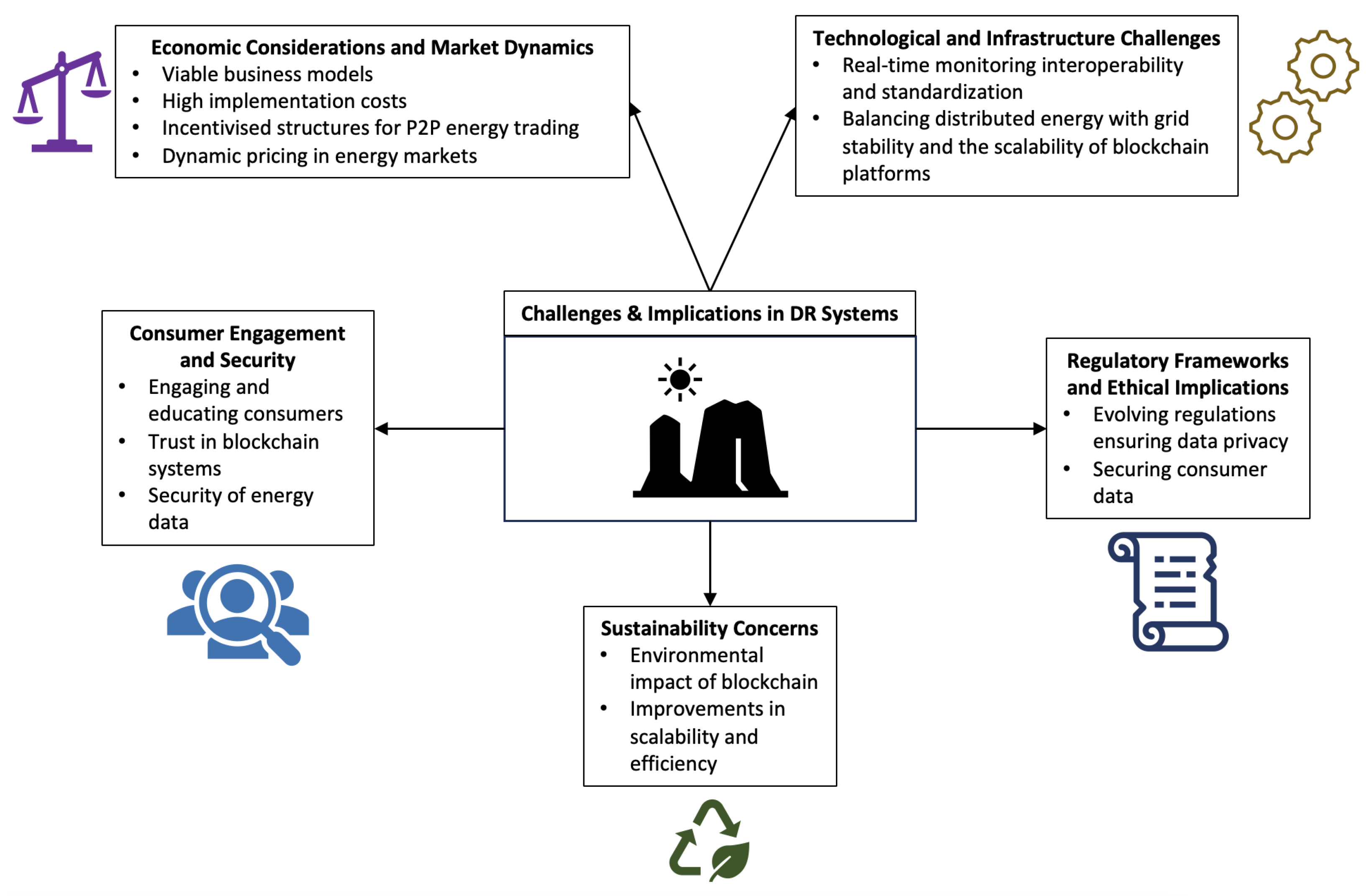
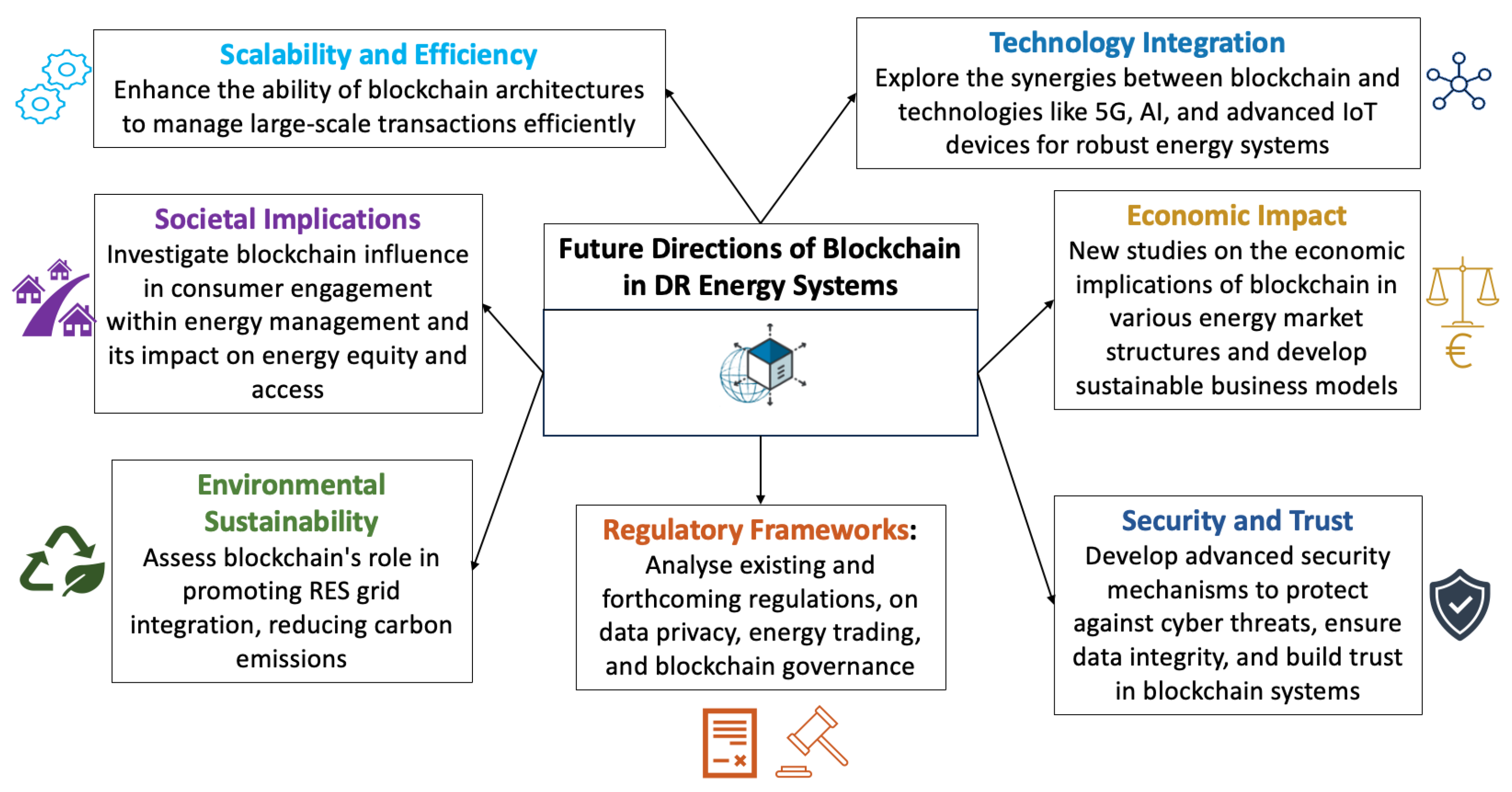
| Criteria | Details |
|---|---|
| Sources | IEEE Xplore, Elsevier, Springer, MDPI, O’Reilly Media, Google Scholar |
| Keywords | ’Blockchain’,’Demand Response’, ’Smart Grid’, ’Energy Management’, ’Renewable Energy’, ’Distributed Ledger Technology’, ’Energy Trading’, ’Smart Contracts’, ’Cybersecurity’, ’Energy Market’, ’Sustainable Energy’, ’Energy Policy’ |
| Search Strings | ’Blockchain and Demand Response’, ’Blockchain in Smart Grid’, ’Renewable Energy and Blockchain’, ’Distributed Ledger Technology in Energy’, ’Smart Contracts for Energy Management’, ’Blockchain Technology in Sustainable Energy’ |
| Inclusion Criteria | Exclusion Criteria |
|---|---|
| Articles published in peer-reviewed journals, conference proceedings, and articles published in reputed journals | Editorial pieces, prefaces, summaries, book reviews, and other non-peer-reviewed materials |
| Studies focusing on blockchain technology application in SGs and demand response and whitepapers | Studies without empirical evidence or that do not provide a clear blockchain application in SGs or DR |
| Publications in the English language | Articles not relevant to the targeted area of blockchain in SGs and DR |
| Articles published between 2004 and 2023 | Non-English articles |
| Type of Benefit | Description |
|---|---|
| Financial Benefits | Clients can achieve cost savings by consuming less energy during high-priced hours or shifting their electricity usage to cheaper hours [11] |
| Reliability Benefits | DR contributes to a reduction in the likelihood of involuntary supply interruptions, such as blackouts [12] |
| Market Performance | DR participation inhibits electric power companies from exercising market dominance, promoting a balanced energy market [21] |
| System Security | DR provides System Operators (SOs) with adaptable tools to manage unforeseen circumstances, enhancing energy system resilience [20] |
| Keyword | Occurrences | Co-Occurrence |
|---|---|---|
| blockchain | 28 | 50 |
| demand response | 28 | 27 |
| smart contract | 9 | 23 |
| smart grid | 10 | 19 |
| smart grids | 7 | 14 |
| microgrids | 3 | 10 |
| transactive energy | 3 | 10 |
| smart contracts | 4 | 9 |
| distributed ledger | 4 | 7 |
| energy management system | 3 | 7 |
| internet of things | 3 | 7 |
| optimization | 3 | 7 |
| consensus | 3 | 6 |
| energy management systems | 3 | 6 |
| demand side management | 3 | 5 |
| load management | 3 | 5 |
| demand response (dr) | 3 | 4 |
| Attribute | Description |
|---|---|
| Decentralization | The absence of a centralized owner or operator minimize human error and manipulation. It also helps avoid extra intermediate transaction fees [43] |
| Transparency | Blocks are distributed to all participants for consensus approval, enhancing data transparency, corruption prevention, and system credibility [39] |
| Immutability and Traceability | The chained data structure of the blockchain allows for easy access to historical data. Modifying a block requires consensus from all participants, bolstering the trust between participants and service providers [44] |
| Automation | SCs automate blockchain operations, increasing productivity, and reducing errors and manipulation caused by human intervention [27] |
| Advantage | Description |
|---|---|
| Open Architecture | Any user can participate in network maintenance and transaction verification, fostering decentralization without central authority reliance |
| Transparency | All transactions are visible to every node, ensuring auditable and verifiable transactions, with considerations for privacy [53] |
| Pseudo-Anonymity | While transactions are transparent, the direct linkage between transaction IDs and real-world identities is obscured [54] |
| Radical Decentralization | Peer-to-peer methodology allows rapid network expansion and scalability without centralized oversight [55] |
| Network Resilience | Highly resistant to attacks, with control over a majority of nodes being practically unfeasible in large networks [52] |
| Advantage | Description |
|---|---|
| Enhanced Security | Geared towards protecting sensitive data, offering secure storage for confidential information [57] |
| Customization | Provides greater control over ledger operations, allowing tailored solutions for specific needs [56] |
| Increased Transaction Speed | Designed for scalability with faster transaction processing compared to permissionless systems [56,57] |
| Decentralization | Offers a level of decentralization, reducing risks associated with centralized database systems |
| Citation | Author(s) | Approach | Platform | Focus Area | Key Benefits |
|---|---|---|---|---|---|
| [64] | Pop et al. | Decentralized DR management | Ethereum | Energy Flexibility, DR Agreements | Grid Efficiency, P2P Energy Trading, Cost Reduction |
| [65] | Pop et al. | SCs with Zero-Knowledge Proofs | Ethereum | Prosumer Data Privacy | Data Transparency and Privacy Balance |
| [66] | Mao et al. | Centralized Bidding Mechanism | Ethereum | Transaction Management | Enhanced Efficiency and Transparency |
| [67] | Park et al. | BPPS for DR Management | Ethereum (Testnet) | Security in SGs | Robust Security, Secure Mutual Authentication |
| [38] | Afzal et al. | Decentralized community MGs | Ethereum | self-renewable generation and shared MG management | Security, P2P Energy Trading, Cost Reduction |
| [68] | Wu et al. | Power Flow Management | MultiChain | Power Flow Calculations, Electricity Pricing | Reduced Manual Intervention, Accurate Transactions |
| [69] | Van Cutsem et al. | Decentralized Framework for Smart Buildings | Ethereum | Consumption Optimization | Local Energy Usage Optimization, Reduced Peak Demand |
| [70] | Tsao et al. | Real-Time Price-Based DR | Ethereum | Sustainability Goals | Operational Profitability, Customer Satisfaction |
| [71,72] | Tsolakis et al. | OpenADR 2.0 Integration | Ethereum, Hyperledger, IOTA, Tendermint | DR Transaction Management | Streamlined Energy Management, Transaction Integrity |
| Citation | Author(s) | Approach | Platform | Focus Area | Key Benefits |
|---|---|---|---|---|---|
| [73] | Zhou et al. | AI and contract theoretical modeling, EVs-based DR | Consortium blockchain | Energy Trading | Lowers computation costs, maximizes social benefits |
| [74] | Samadi et al. | DR Stackelberg game model, conserving DERs | Blockchain-based system for DR, novel Proof of Energy Saving (PoES) consensus algorithm | Cooperative Distributed Storage | Encourages energy use reduction, engages in block mining for rewards |
| [75] | Guo et al. | Dual-incentive DR scheme | Consortium blockchain | Energy Management Efficiency | Reduces electricity costs, addresses system imbalances |
| [76] | Bracciale et al. | Hyperledger Fabric for distributed EMS in DR | Hyperledger Fabric | Privacy in Energy Management | Enhances privacy, Secure Multiparty Computation protocol |
| [77] | Lucas et al. | DLTs for DR provision and validation | Hyperledger Fabric | Data Integrity and Origin | Ensures data integrity, permissioned ecosystem |
| [78] | Danzi et al. | SC for DR Programs | Private Ethereum | Energy Procurement and Imbalances | Automation, New Business Models for BRPs |
| [79] | Lin et al. | Blockchain Power Trading | Private Ethereum | EV Charging, Energy Management | Facilitates Power Transactions, Optimises Green Power Usage |
| [80] | Yang et al. | Transactive EMS for Smart Homes | Private blockchain-based energy management platform | Energy Trading, User Privacy | Peer-to-Peer Energy Trading, Enhanced System Efficiency |
| [81] | Deshpande et al. | Permissioned blockchain framework for DR marketplace | Any private permissioned blockchain | Transparency and Decentralization | Enhanced transparency, efficient DR allocation model |
| [82] | Di Silvestre et al. | Distributed DR mechanism using blockchain and SCs | Hyperledger Fabric | Interaction with DSO | Ensures fairness and privacy, load adjustment requests |
| [83] | Wang et al. | Energy management model for renewable energy MGs | Hyperledger Fabric | Renewable Energy MGs | Ensures privacy and security, reduced communication delays |
| [84] | Merrad et al. | Decentralized architecture for DR management using SCs | Compatibility with Ethereum or similar platforms | Decentralized Energy Generation Management | Nash game approach for fairness, Optimal Power Flow (OPF)-based demand response management system |
| [85] | Li et al. | Blockchain-based trans-active EMS | Ethereum and Hyperledger Fabric or similar | Networked MGs and Local Distribution Grid | Transparency and trustworthiness, automates energy trades |
| [86] | Augello et al. | Hyperledger Fabric with SCADA systems | Hyperledger Fabric | Aggregating DR Energy Resources | Robust and efficient solution for DR management |
| [87] | Sciume et al. | Blockchain-based distributed DR service | Hyperledger Fabric | Tracking and Certification | Transparency and fairness in customer participation |
| [88] | Di Silvestre et al. | Blockchain technology and SCs for DR compensation | Hyperledger Fabric | DR Compensation System | Trustworthiness and transparency, direct interaction |
Disclaimer/Publisher’s Note: The statements, opinions and data contained in all publications are solely those of the individual author(s) and contributor(s) and not of MDPI and/or the editor(s). MDPI and/or the editor(s) disclaim responsibility for any injury to people or property resulting from any ideas, methods, instructions or products referred to in the content. |
© 2024 by the authors. Licensee MDPI, Basel, Switzerland. This article is an open access article distributed under the terms and conditions of the Creative Commons Attribution (CC BY) license (https://creativecommons.org/licenses/by/4.0/).
Share and Cite
Koukaras, P.; Afentoulis, K.D.; Gkaidatzis, P.A.; Mystakidis, A.; Ioannidis, D.; Vagropoulos, S.I.; Tjortjis, C. Integrating Blockchain in Smart Grids for Enhanced Demand Response: Challenges, Strategies, and Future Directions. Energies 2024, 17, 1007. https://doi.org/10.3390/en17051007
Koukaras P, Afentoulis KD, Gkaidatzis PA, Mystakidis A, Ioannidis D, Vagropoulos SI, Tjortjis C. Integrating Blockchain in Smart Grids for Enhanced Demand Response: Challenges, Strategies, and Future Directions. Energies. 2024; 17(5):1007. https://doi.org/10.3390/en17051007
Chicago/Turabian StyleKoukaras, Paraskevas, Konstantinos D. Afentoulis, Pashalis A. Gkaidatzis, Aristeidis Mystakidis, Dimosthenis Ioannidis, Stylianos I. Vagropoulos, and Christos Tjortjis. 2024. "Integrating Blockchain in Smart Grids for Enhanced Demand Response: Challenges, Strategies, and Future Directions" Energies 17, no. 5: 1007. https://doi.org/10.3390/en17051007
APA StyleKoukaras, P., Afentoulis, K. D., Gkaidatzis, P. A., Mystakidis, A., Ioannidis, D., Vagropoulos, S. I., & Tjortjis, C. (2024). Integrating Blockchain in Smart Grids for Enhanced Demand Response: Challenges, Strategies, and Future Directions. Energies, 17(5), 1007. https://doi.org/10.3390/en17051007









